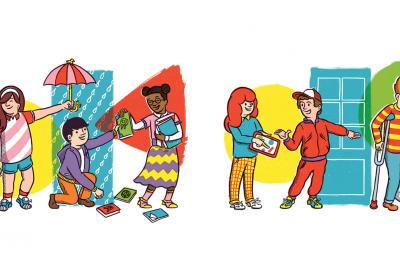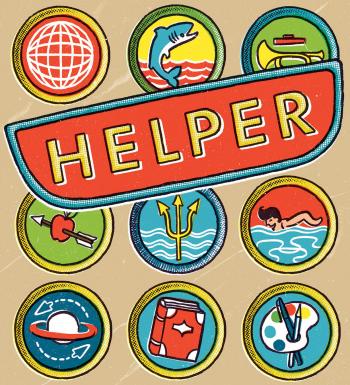After 20 years as a teacher and counseling aide at Ala Wai Elementary School in Honolulu, Hawaii, Thomas Yos carries with him something a parent once said. “He put it really nicely,” Yos recalls. “He said, ‘Us parents want our kids to be smart. But even more than that, we want them to be good.’”
Adam Grant, a professor at the University of Pennsylvania and author of Give and Take: Why Helping Others Drives Our Success, echoed this thought in an opinion piece he wrote for The New York Times, “Raising a Moral Child.” In this pivotal essay, Grant pointed to global surveys showing that people tend to value caring more than achievement. Grant was writing about parenting, but facilitating the development of strong moral and ethical foundations—what some call character education—is not the purview of parents alone, Grant says; early educators play a role too. Moral education is often unintentionally neglected, however, as teachers must increasingly focus on mandates related to standards alignment and standardized testing.
“You know when your students can read and write,” says Grant. “When you try to teach character, truly, you feel like you’re not even moving the needle a little bit. You think you’ve gotten through a really important message about ‘don’t hit your classmates,’ and then the next day they start hitting each other.”
It’s clear that the public wants schools to focus on moral education. In a recent PDK/Gallup poll, 76 percent of respondents agreed with the statement: “Today’s schools should build students’ character.” And educators want the same thing. As Yos points out, teaching children academic and professional skills without giving them a moral compass is a good way to produce clever criminals.
But how can early educators aid moral development?
It’s a question that requires a caveat: Moral education is not social indoctrination. Trying to hammer specific moral opinions into children’s minds does not help them make moral decisions, notes Elliot Turiel, professor and Jerome A. Hutto chair at the University of California, Berkeley Graduate School of Education.
“It’s not a matter of being taught values by parents or teachers, but rather that children come to understand basic ideas about fairness, justice, rights and people’s welfare,” Turiel says.
Most experts agree that by the age of 2 or 3, children start to experience emotions relating to events they perceive to be right or wrong. By age 4 or 5, those nebulous feelings start to crystallize into a fundamental sense of fairness, says University of Maryland developmental psychologist Melanie Killen.
“That doesn’t mean that they understand everything there is to the concept of fairness,” Killen says. “So what we say is that a notion of fairness evolves throughout childhood and adolescence.”
This means that the preschool and elementary years are times when educators can make a difference. Conflict resolution is a good area of focus during the younger end of that spectrum, Killen says, noting that a child’s first brushes with fairness often involve an object conflict or turn-taking issue: a child has taken a toy or is hogging the swings.
The instinct for teachers may be to resolve the conflict quickly and move on, but Killen advocates that these incidents offer learning opportunities. Explaining why an action was fair or unfair and starting a discussion where the child can arrive at a fair outcome on his or her own is a simple but powerful approach. Another is discussing intentions. Conflicts among young children commonly occur because they don’t understand the concept of positive intentions with negative outcomes (e.g., a toy being broken accidentally). With age and explicit discussion, children can come to see the difference between intent and outcome and adjust their behavior accordingly.
“Educators need to help children think about issues of fairness in the context of their peer interactions and everyday life,” Killen says. “It’s not punishment and removing kids from situations—time-outs. Those kinds of strategies are just not effective.”
Nadia Chernyak, a researcher at both Brown and Harvard University, conducted an experiment in which preschoolers could share stickers with a “sad” puppet in one of three situations: children were given a costly choice (they could either give up the sticker or keep it); a non-costly choice (they wouldn’t get to keep the sticker either way); or no choice (they were told to give it). The children were later given the choice to share again in the experiment’s second phase.
“It was the children who actually got the difficult or the costly choice in the first phase who were more likely to share or shared more in the second phase,” Chernyak says. “It’s in these kinds of high-cost situations that a lot of learning can happen.”
Chernyak says that educators are in a unique position to provide children with opportunities to make tough choices about sharing, and to guide their learning from these choices.
“One of the things I think teachers and parents are particularly good at is knowing exactly what the child is capable of,” Chernyak says. “Once a child is at that point where they’re capable of making that difficult choice, probably parents and educators can take advantage of that.”
The manner in which caring behavior is discussed also matters, even down to the use of nouns versus verbs. A recent study published in Child Development found that, with 3- to 6-year-olds, conversations about “being a helper” yielded significantly more helpful behavior in future tasks than conversations about “helping.”
“A really important distinction is that being a helper is something about the kind of person who you are,” says University of Washington researcher Allison Master, one of the study’s authors. “It changes it from a behavior that you do or you don’t do into something that has implications for who you are or who you are not.”
Nearly 30 years ago, Joan E. Grusec of the University of Toronto found similar results in a study comparing 7- to 10-year-olds who were praised for sharing. The children were complimented with either a noun or a verb structure, then given a later opportunity to donate to a canned food drive.
“We found that the children who had been told they were helpful people brought in a lot more than the children who had simply been rewarded for sharing. What we take away from that is that reinforcing or saying ‘that’s a good thing you did’ is much less effective—it can even be harmful—than making the child see themselves as just the kind of person who helps others,” Grusec says.
Grant advocates an opposite approach for dealing with uncaring behavior. He suggests the best approach is to express disappointment in the action rather than the person, explaining why the action was wrong and how it affected others.
“If you criticize bad behavior along with praising character, then when you express disappointment you will have these kids who say, ‘I am a helper, but I did not help in this situation. I need to repair it. I need to fix it. I need to do something different in order to regain my identity as a helper.’ Those two opposites are really important,” Grant says.
Grant notes that praise of character appears to be most effective around age 8, when children are developing a stronger sense of individual identity. But children begin to separate themselves into groups based on identity characteristics like gender, race, ethnicity and school activities beginning as early as preschool. This fact makes it critical that early childhood educators be aware of how moral judgments related to fairness, equality and group identity develop.
It's not a matter of being taught values by parents or teachers, but rather that children come to understand basic ideas about fairness, justice, rights and people's welfare.
In-group preference (preference for the group to which one belongs) is not in itself a negative thing, says Yarrow Dunham, a Yale University professor and researcher on intergroup social cognition.
“It’s initially more about ‘I like my group more’ and less about ‘I like the other group less.’ It doesn’t immediately become dislike for the out-group,” Dunham says.
Out-group dislike—the basis for bias and intolerance—can develop due to polarizing factors like competition, Dunham says. Killen adds things like explicit prejudice, lack of inter-group contact and hierarchical unfairness to that list, but notes that when children are given the choice between basic fairness and in-group preference, they will typically choose fairness.
“It’s very important for educators, teachers, parents to be talking about [stereotypes and exclusion] explicitly,” Killen says. “There are a lot of ways you can do it; you can set this up as a discussion. Present it as, ‘Hey, I’m a reporter. Something happened, let’s talk about it.’… Kids will talk about these things; it’s just that they’re never asked.”
Grant suggests a twist on the common classroom activity of storytelling to make children think about exclusion.
“A common classroom activity that is often used in the studies in this area would be something like ‘We’re going to read a story about a child who is not inviting another child to a birthday party,’” Grant says. “Instead of just reading the story, the class discussion should focus on ‘How do you think the child who wasn’t invited felt? What’s it like to be that child?’”
In-group/out-group identity, he says, can be a significant moral obstacle and an area that needs more focus from researchers and educators.
“I would love to see more educators focus on the circle of concern. A lot of parents, particularly in the U.S., tend to be very parochial and provincial in the way we teach caring values. You basically learn to care about your family unit and your friends and neighbors, and that’s about it. That creates a really stark ‘in-group/out-group’ divide, where children don’t learn to care about those who are different from them. That’s where most of our problems occur in the world.”
Learning Aloha
For two decades, Thomas Yos has taught students at Honolulu’s Ala Wai Elementary School to think and act morally, but he’s never relied on a list of virtues or simplistic allegories like those found in old-school character education resources. Instead, Yos uses the power of the school environment.
“It’s a place where people care about each other and show that they do,” Yos says. “When I explain it to my elementary-school students, a lot of times I use the Hawaiian word aloha, which, in addition to meaning ‘hello’ and ‘goodbye,’ also means ‘love’ and a deep connectiveness between people.”
Yos holds a doctorate in philosophy and does outreach through the University of Hawaii’s Uehiro Academy, working with the “community of inquiry” developed by Philosophy for Children, an international reasoning skills program. Now in the counseling department after years of teaching, he facilitates student-led discussions about moral challenges. Generally kids set the topics: bullying, playground indiscretions or why their parents yelled at them. Yos serves as a guide but is careful to allow students to come to their own conclusions about what happened and the right way to respond.
“You kind of get a double-dose of character education. You’ve got the kids talking and reflecting on questions like bullying or how we should treat each other. So you have character education that way, and you’ve also got it by creating this community of aloha where people care for each other,” Yos says. “My approach is less telling kids how they should behave—saying ‘OK, these are the virtues, you should act like this’—but rather creating an environment where these things are lived and practiced.”




0 COMMENTS